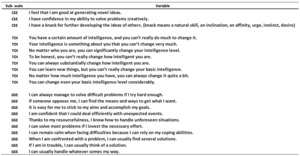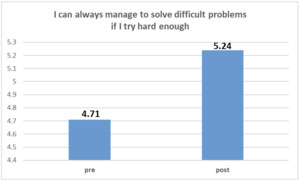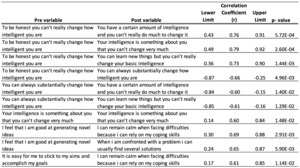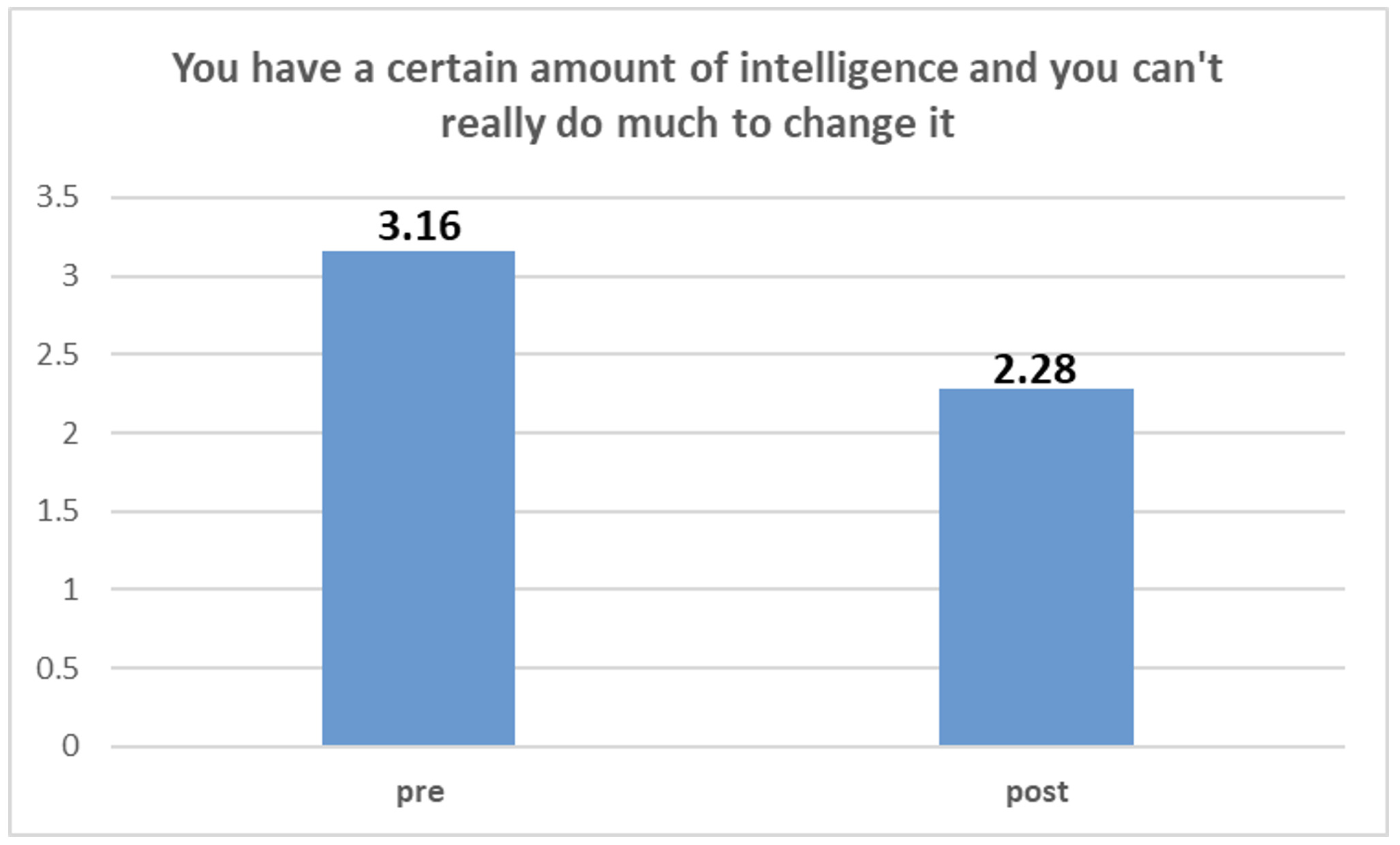Introduction
A critical threat to addressing the nation’s STEM workforce needs is student persistence and retention in STEM disciplines at the undergraduate level. Many students matriculating as STEM majors later transfer to major in non-STEM related fields (Whalen & Shelley, 2010) or fail to re-enroll in the sophomore year (Chen, 2013). Students from STEM fields demonstrate lower within-field grade point average (GPA) and persistence rates relative to students from non-STEM fields (King, 2015). This is of concern as lower within-field GPAs predict lower academic persistence (King, 2015). Similarly, a student’s cumulative GPA in their last registered term is a dominant predictor of six-year retention and graduation rates (Whalen & Shelley, 2010).
These trends are exacerbated for minoritized students (Whalen & Shelley, 2010). Among Black undergraduates, 40% switch from STEM to other majors, compared to only 29% of White undergraduates; while 26% of Black STEM majors leave without a degree, compared to 13% of their White counterparts (Riegle-Crumb et al., 2019). The successful retention of racially and ethnically diverse undergraduate STEM majors remains a challenge for higher education institutions and poses a significant threat to the size, diversity, and innovation of the future STEM workforce (National Science Foundation, 2010).
Historically Black Colleges and Universities (HBCUs) are uniquely positioned to make valuable contributions to addressing these national STEM workforce needs. National statistics indicate that HBCUs play a significant role in matriculating, retaining, and successfully graduating STEM professionals in the US (Gasman & Nguyen, 2014). Although HBCUs represent a minority of post-secondary institutions within US higher education, one-third of Black students who complete doctoral degrees in STEM earned their undergraduate STEM degrees at an HBCU (Upton & Tanenbaum, 2014).
HBCUs are national leaders in the education of Black STEM students and can serve as effective models for creating cultures that support marginalized students toward academic success (Boncana et al., 2021; Rankins, 2019; Taylor & Wynn, 2019). STEM faculty leadership and administration at all levels of academia are a critical link in the chain that promotes STEM student retention and persistence (Chung et al., 2023; Collins & Olesik, 2021; Toldson, 2013). Transformational change efforts facilitated by STEM leaders at HBCUs can impact the institutional structures and processes that contribute to broadening participation efforts at the national level (Blackmon et al., 2021; Clavier et al., 2021). The institutional and leadership characteristics of HBCUs that enhance their success in broadening participation include the commitment of leadership to STEM education and the implementation of STEM student support strategies (Jaeger et al., 2021).
The University of the Virgin Islands (UVI) is a US accredited institution of higher learning and an HBCU located in the Caribbean. It is the sole institution of higher education within the Virgin Islands territory and serves a predominantly minoritized community. The territory’s demographic is reflected in a matriculating undergraduate student demographic of 65% Black non-Hispanic and 10% Hispanic/Latinx (University of the Virgin Islands, n.d.-a). Territorial statistics indicate that only 22.3% of Virgin Islands’ residents have a bachelor’s degree or higher (KIDS COUNT Data Center, n.d.), and a smaller proportion hold degrees in STEM-related fields. In 2015, one-third of children within the territory resided in families below the federal poverty level (Community Foundation of the Virgin Islands, 2019). National data indicate that similar demographics place students at risk for lower academic performance and lower rates of retention (Cataldi et al., 2018). Historically, UVI has had a 63% overall undergraduate retention rate (University of the Virgin Islands, n.d.-b).
To better address the needs and challenges of its undergraduate student population, UVI has developed a student-centered retention model called the UVI Growth Model (Mills et al., 2020; National Science Foundation, n.d.; Stolz et al., 2022). This builds on the Tinto model (Tinto, 2012) of student retention and focuses on building self-efficacy among STEM students at this HBCU. The UVI Growth Model is rooted in growth mindset principles and is characterized by integrating formal and informal learning opportunities, mentoring, research experiences, and professional development. These intervention strategies target students at varying stages of their academic experience.
Research has found that pre-college STEM intervention results in an increase in STEM sense of belonging and identity which, in turn, promotes increased undergraduate persistence in STEM (Findley-Van Nostrand & Pollenz, 2017; Kuchynka et al., 2019). Reported outcomes of pre-college intervention programs highlight the effectiveness of such programs, including a first-year retention rate of 98% (Findley-Van Nostrand & Pollenz, 2017), higher grade point averages (Kassaee & Rowell, 2016), and retention of STEM major by historically marginalized students up to the third year of the undergraduate experience (Tomasko et al., 2016). Interventions targeted at freshman students have been found to be effective at enhancing retention and academic performance (Boudreau & Kromrey, 1994). While academic interventions aimed at promoting student success generally target freshman students, additional interventions at later stages of a student’s academic career may be required to enhance academic performance, improve overall retention in the student’s program of study, and successfully meet the student’s expected timeline for program completion and graduation. Data indicate that rising sophomore interventions are also critical to student retention (Bowling et al., 2013; Cicciarelli et al., 2018, 2020; Lisberg & Woods, 2018; Whittaker et al., 2016), particularly in STEM-related fields. Osegura et al. (2019) identified a strong scientific identity as a positive contributor to STEM student retention among minoritized groups within the first two years of embarking on an academic scholar program.
Developing and implementing effective psychosocial interventions to meet the current challenges students face may be crucial to the academic success of historically minoritized students, who often face a unique set of challenges relative to their non-minoritized peers. Previous studies have reported positive learner outcomes from psychosocial interventions (Findley-Van Nostrand & Pollenz, 2017; Lisberg & Woods, 2018; Lytle et al., 2021; Paz et al., 2015), while some highlight the particular effectiveness of these implementations with learners from historically marginalized groups (Ben-Zeev et al., 2017; Jordt et al., 2017; Lisberg & Woods, 2018). Growth mindset interventions that focus on transitioning a learner’s perception of intelligence from a fixed to a growth mindset have been shown to be particularly successful. The design and implementation of growth mindset strategies and curricula have been extensively aimed at pre-undergraduate learners (Brougham & Kashubeck-West, 2017; Stohlmann, 2022; Yeager et al., 2019), but similar strategies and curricula designed for undergraduate or adult-age learners may be just as effective in positively impacting theories of intelligence in this target group (Hacisalihoglu et al., 2020; Lisberg & Woods, 2018; Nallapothula et al., 2020).
This article shares the design and implementation of an innovative enrichment program aimed at increasing minoritized student retention in STEM and the impact of custom-designed curricula on implicit theories of intelligence, general self-efficacy, and creative self-efficacy among undergraduate minoritized learners. This research explored the impact of the UVI Growth Model component, known as Summer Boost, on learners’ theories of intelligence, general self-efficacy, and creative self-efficacy, and hypothesized that participation in the Summer Boost program would positively impact each of these among participants.
Background
Summer Boost, formerly known as Sophomore Boost, is an innovative summer enrichment program for early-stage university students. The program targets STEM undergraduate students experiencing academic challenges and whose early STEM college experiences may not have been successful with regard to achieving their academic goals. Potential participants are reviewed according to GPA, credit hours, and academic performance criteria. General criteria include completion of fewer than 60 credit hours, a GPA of less than 2.5, and a final course grade of C- or lower in at least one STEM course. Currently enrolled students who meet these criteria are contacted by representatives from the UVI Center for Student Success (CSS), Summer Boost program administration, or curriculum instructors, and participants are accepted into the program based on available space within the cohort. Over the course of its implementation, cohorts have included diverse STEM majors, including biology, computer science, applied math, and process technology. In the summer of 2018, non-STEM major participants were also recruited and supported in the Summer Boost program through Department of Education Title III funding. This has further diversified the cohort pool and the variety of student experiences within the learning community. When funding is available, selected participants are granted a stipend and the opportunity to retake a course in which they received a grade of C- or lower, at no cost to the participant.
In the summer of 2016, an initial implementation of the program was piloted; since 2017, the program has been fully implemented. The enrichment program consists of a six-week customized intervention, that includes custom-designed curricula created and facilitated by four instructors. The main curricular components are Self-Efficacy and Growth Mindset, Creativity and Creative Thinking, Innovation and the Internet of Things, and Entrepreneurship, with the latter component added to the curriculum in 2018. Each custom-designed intervention module is associated with selected learning outcomes (Table 1).
The initial implementation of the program included a six-week intervention with an in-person residential component that included housing and meals at no cost to the participants. In the summer of 2020, due to local and federal physical distancing guidelines related to the COVID-19 pandemic, the implementation transitioned to a virtual format mediated through readily accessible video-conferencing software, with participants exposed to the same general curricular content for all intervention modules.
In 2019, the enrichment program was renamed the Summer Boost Program in an effort to more effectively engage student interest and reduce the potential applicant confusion surrounding the concept of “sophomore” versus “rising sophomore”.
Leadership Positionality Statement
Verleen McSween: I am an African American and Afro-Caribbean female scholar and a product of the HBCU undergraduate system. Through my lived experiences, I have seen and experienced the positive impact of the HBCU culture of success, excellence, and care on the minds of young learners, particularly those from historically minoritized groups. My current research efforts focus on broadening the participation of minoritized learners in advanced STEM training pathways, as well as in the STEM workforce, while my service efforts focus on broadening early career faculty participation in STEM education, and promoting early career scholarship, productivity, and socialization into the academy. I consider myself a servant-leader and an opportunity broker for my HBCU students and faculty peers. I live out this identity by promoting inclusivity and equity in teaching, learning, research, and service. I utilize a growth mindset approach to leadership that emphasizes “failing up” as part of the process of student development and growth, as well as creating a “not yet” atmosphere for early career faculty success.
Robert Stolz: My social identity shapes my leadership positionality, significantly influencing my approach to broadening participation in STEM. Growing up in a single-parent household with limited financial resources has had a lasting impact on me. While my identity offers me unique perspectives, I am acutely aware of the potential biases I may carry. My leadership style is anchored in motivation, a shared sense of purpose, and an unwavering commitment to continuous learning. I aspire to inspire others to actively engage in STEM while recognizing the paramount importance of diversity and inclusion in our collective endeavors. I remain open to various perspectives and am dedicated to fostering an inclusive STEM community where every voice is heard and valued.
Methods
A quantitative study design was utilized to evaluate the impact of the Summer Boost intervention on participants’ theories of intelligence, general self-efficacy, and creative self- efficacy. Participants completed a survey assessment prior to participating in curricular activities and upon completion of the intervention. The pre- and post-intervention survey instrument was composed of three separate subscales which assessed participant creative self-efficacy (CSE, three items), implicit theories of intelligence (TOI, eight items), and general self-efficacy (GSE, ten items) (Stolz et al., 2022). Participants were asked to evaluate statements on a 6-point Likert scale (1 – strongly disagree to 6 – strongly agree). The sample size consisted of, in total, 31 participants from the Summer 2020 and Summer 2021 cohorts. In addition, 16 matched surveys were analyzed to evaluate possible correlations between pre- and post-intervention responses.
Descriptive statistics were generated for each subscale item, including mean and standard deviation. An independent sample t-test (α ≤ .05) was used to assess the statistical difference between pre- and post-intervention response means for each subscale item.
To evaluate the direction and strength of the linear relationship between participant responses to scale items, a correlation matrix was constructed by calculating the Pearson’s correlation coefficient (r) between pairs of scale items. The 95% confidence interval of the differences between variables was also calculated. An r value of 0.7 was used as the threshold for indicating the presence of a strong linear relationship between scale items (0 to 0.1 = no relationship; 0.1 to 0.39 = weak; 0.4 to 0.69 = moderate; 0.7 and above = strong).
Results
A comparison of participants’ pre- and post-intervention responses revealed the following item on the TOI subscale to be statistically significant: “You have a certain amount of intelligence, and you can’t really do much to change it” (Mpre= 3.16, Mpost= 2.28; SD= 1.21)(t(54) = 2.16, p = .04) (Figure 1). Two additional TOI subscale items were found to be moderately statistically significant based on an alpha of 0.10: “Your intelligence is something about you that you can’t change very much” (Mpre= 3.45, Mpost= 2.6; SD= 0.85)(t(50) = 1.84, p = .07) and “To be honest, you can’t really change how intelligent you are” (Mpre= 2.97, Mpost= 2.24; SD= 1.66)(t(53) = 1.69, p = .097). The mean score for each of these subscale items declined from pre- to post-intervention responses, demonstrating decreased agreement with these statements.
Similarly, the following item on the GSE subscale was determined to be statistically significant: “I can always manage to solve difficult problems if I try hard enough” (Mpre= 4.71, Mpost= 5.24; SD= 1.27)(t(50) = -1.99, p = .05) (Figure 2). Three additional GSE subscale items were found to be moderately statistically significant: “It is easy for me to stick to my aims and accomplish my goals” (Mpre= 4.48, Mpost= 5.00; SD= 1.54)(t(51) = -1.72, p = .09), “I am confident that I could deal efficiently with unexpected events” (Mpre= 4.26, Mpost= 4.92; SD= 0.86)(t(51) = -1.87, p = .07), and “Thanks to my resourcefulness, I know how to handle unforeseen situations” (Mpre= 4.45, Mpost= 4.96; SD= 1.14)(t(52) = -1.89, p = .06). The mean score for each of these subscale items increased from pre- to post-intervention responses, demonstrating increased agreement with these statements.
Participant responses to several scale items were found to be strongly correlated to their responses to other scale items, with a Pearson’s coefficient of correlation at or above 0.7. These associations were observed for both pre- and post-intervention responses.
The relationship between the following pairs of pre- and post-intervention TOI subscale items were found to be negative, moderate in strength, and statistically significant (Table 3): “You can always substantially change how intelligent you are” and “You have a certain amount of intelligence, and you can’t really do much to change it” (r(x)=-0.60,p=.01); “To be honest, you can’t really change how intelligent you are” and “You can always substantially change how intelligent you are” (r(x)=-0.66,p=.005); and “You can always substantially change how intelligent you are” and “You can learn new things, but you can’t really change your basic intelligence” (r(x)=-0.61,p=.01).
In contrast, the pre-intervention TOI subscale item “To be honest, you can’t really change how intelligent you are” and three TOI post-intervention subscale items were found to be positive, strong, and statistically significant (Table 3): “You have a certain amount of intelligence, and you can’t really do much to change it” (r(x)=-0.76,p<.001); “Your intelligence is something about you that you can’t change very much” (r(x)=-0.79, p<.001); “You can learn new things, but you can’t really change your basic intelligence” (r(x)=-0.73, p=.001), respectively.
Similarly, the CSE subscale item, “I feel that I am good at generating novel ideas,” and the following two GSE subscale items were positive, moderate in strength, and statistically significant (Table 3): “I can remain calm when facing difficulties because I can rely on my coping abilities” (r(x)=-0.69, p=.003) and “When I am confronted with a problem, I can usually find several solutions” (r(x)=-0.65, p=.006). The GSE subscale items “It is easy for me to stick to my aims and accomplish my goals” and “I can remain calm when facing difficulties because I can rely on my coping abilities” (r(x)=-0.61, p=.01) were also positive, moderate in strength and statistically significant.
Additional analysis revealed that several GSE pre-intervention subscale items were correlated to other GSE pre-intervention subscale items. All of these correlations were found to be positive, strong, and statistically significant (Table 4).
Similarly, several post-intervention subscale items were correlated to other post-intervention scale items (Table 4). For example, the relationship between the post-intervention TOI subscale item “You can change even your basic intelligence level considerably” and two TOI subscale items: “You can always substantially change how intelligent you are” (r(x)=-0.77, p<.001) and “No matter how much intelligence you have, you can always change it quite a bit” (r(x)=-0.76, p<.001) were positive, strong, and statistically significant. A similar relationship was observed for the TOI subscale items, “You can learn new things, but you can’t really change your basic intelligence” and “To be honest, you can’t really change how intelligent you are” (r(x)=-0.88, p<.001). This was also observed for the CSE subscale item, “I have confidence in my ability to solve problems creatively” and the TOI subscale item, “No matter who you are, you can significantly change your intelligence level” (r(x)=-0.79, p<.001).
Discussion
In this study, a psychosocial intervention, in the form of a custom designed curriculum, was used to address the needs of undergraduate STEM students experiencing academic challenges early in their university careers. The curricula employed four modules that exposed learners to growth mindset/self-efficacy, creativity, entrepreneurship, and the Internet of Things. The intervention had a positive impact on some measures of implicit theories of intelligence and general self-efficacy. Multiple correlations were observed among sub-scale items. Moderate negative correlations were observed between growth-minded and fixed-minded statements. In contrast, strong positive correlations were observed between growth-minded statements and between fixed-minded statements. A growth-minded scale item was also demonstrated to have strong positive correlation to a creative self-efficacy subscale item. General self-efficacy subscale items were found to have moderate positive correlations with creative self-efficacy items, as well as with other general self-efficacy items.
Previous studies have demonstrated a relationship between theories of intelligence and factors including increased academic engagement, higher GPA, and greater enjoyment of the academic process (Aronson et al., 2002); STEM interest, STEM engagement, sense of belonging in the STEM environment, and academic persistence (Lytle & Shin, 2020); and, in research conducted with children, achievement and goal orientation (Dweck & Bempechat, 2017). Other studies have also demonstrated a relationship between self-efficacy and factors such as academic achievement/performance gains (Ballen et al., 2017; Beatson et al., 2020; Blackmore et al., 2021; Marshman et al., 2018), STEM career interests (Carpi et al., 2017; Luo et al., 2021; van Aalderen‐Smeets et al., 2019), and academic retention rates (Johnson & O’Keeffe, 2016; Lytle et al., 2021). Lytle and Shin (2020) have noted that incremental theories of intelligence predict increased STEM self-efficacy, which is then predictive of higher STEM interest and sense of belonging.
The impact of the intervention on participants’ implicit theories of intelligence and general self-efficacy could potentially serve as a short-term indicator of increased academic persistence among this cohort of participants. However, additional longitudinal follow-up is needed to confirm long-term persistence among the cohort. Curricular content and activities may have reinforced students’ current implicit theories of intelligence and general self-efficacy, via application and practice of related concepts. However, our results indicate that curriculum design requires further improvement to enhance its effectiveness and impact on participants’ implicit theory of intelligence and general self-efficacy. The continual refinement and implementation of similar interventions targeting learners’ theories of intelligence and self-efficacy may positively impact minoritized students at high risk of attrition early on in STEM undergraduate programs (Henry et al., 2019). These early intervention strategies may increase the success and retention of historically marginalized students in STEM majors and support the growth and diversification of the future STEM workforce.
Acknowledgments
This material is based on work supported by the National Science Foundation under Grant Number 1623126.
Verleen McSween, PhD is an Assistant Professor of Biology at the University of the Virgin Islands. She is Director of the Mentoring and Research Infrastructure Component at the Virgin Islands Institute for STEM Education Research and Practice, funded by NSF EPSCOR. Her current work focuses on characterization of institutional support structures at HBCUs that facilitate entry of STEM learners into the STEM workforce, and the retention of STEM professionals in STEM career fields. She is also co-PI on the NIH-funded Undergraduate Research Training Initiative for Student Enhancement (U-RISE).
Robert Stolz, PhD is a Professor of Mathematics and Chair of the Department of Mathematical Sciences at the University of the Virgin Islands. His current work focuses on computational applications in the field of biological sciences, specifically, proteomics, coral disease, and fish spawning. He has developed computational science curricula and implemented PLTL into developmental math courses across the institution to enhance student preparation in STEM. He was previously co-PI on the NSF HBCU-UP and NIH MARC projects and is currently co-PI on the NIH-funded U-RISE project.










